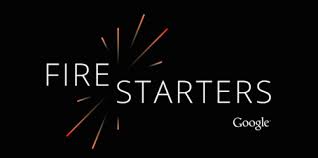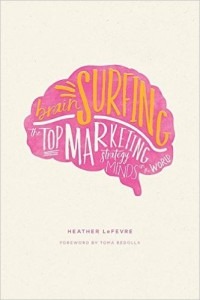I’ve spent the past two evenings at the now familiar Google UK large meeting room for planning & strategy focused evenings of talks. That plus several brilliant interview recordings for the podcast and my brain is buzzing somewhere between wired and fried right now.
On Tuesday was the Account Planning Group’s Noisy Thinking event with the theme of “Planning in a Post-Capitalist World”. I attended the APG “Think like a CSO” event last week with Matt Willifer, CSO of the Engine group advertising agency WCRS, and that was great. Matt showed the us real working pitch decks and took us through the process of developing the strategy and creative for real client projects. It was a great morning event and enriching to see other people’s work. It’s quite rare for agencies and clients to be ready to share this kind of work to an audience, even when agreed to be confidential as it was for this event.
Back to Noisy Thinking this week, it was a pretty lofty theme so I wasn’t sure what to expect or if I’d understand much of it. I wasn’t even sure what post-capitalism meant, even though I’d vaguely heard the word. Even now I’d probably try to nod sagely if I heard someone say it and pretend something like being so torn on the topic that words couldn’t even properly express my opinion. I would generously let said person express their opinion on the matter, listen attentively and do my best to get what they’re talking about.
Apparently the term was coined (or popularised perhaps?) by author and journalist Paul Mason with a book published this year and titled Post-Capitalism: A Guide to our Future.
The first person speaking was Kirsty Fuller, the co-founder and co-CEO of Flamingo, who also sponsor the Noisy Thinking series of events. Flamingo is a insight and strategy consultancy, as I understand it they run large consumer research projects and advise businesses about people and culture to help them build better brands. Kirsty talked about social change becoming of increasing importance for businesses and brands, more than lip-service or greenwashing. She cited examples like Unilever and their Sustainable Living Plan. They are considered leaders in declaring and implementing significant plans towards reducing environmental footprint throughout their business and many brands.
The second speaker was Fern Miller, Chief Strategy and Insight Officer for DigitasLBi, a large digital agency and part of the Publicis Groupe. Fern told us of a really interesting piece of research they conducted with young people in several parts of the world and the influence social media and trends such as taking selfies was having on their behaviour, their self-image, confidence, and the way they see the world through the lenses of selfies and social networks.
The last speaker was Tracey Follows, APG Chair and Futurist at AnyDayNow – not the 2012 homonymic movie, but a consultancy she founded. They are a futures company specialising in the future of communications, media, and brands. Tracey started with the Paul Mason book reference, which most of the audience hadn’t read. It was an interesting theory talk about an idea that society is moving from being consumer-led to being user-led, and society perhaps moving to what Tracey called a ‘Capitalist +” model rather than “Post-Capitalist”.
I’m not too sure what the combination of talks really means for planners and the discipline in this “post-capitalist” world but it was certainly interesting. The more experienced I become in my job as a strategist, the more I think that while many elements of society are becoming complex, as long as businesses and organisations want to sell their stuff / ideas / services to people then there will be a role for me and other planners / strategists to help them understand how best to do that.
I caught up with John Griffiths at the end of the evening, and talked about some of the latest interviews of some of the first advertising account planners in preparation for the book he is working on with Tracey and that I’m really looking forward to, 98% Pure Potato.

Yesterday was the popular series curated by Neil Perkin of Only Dead Fish, Google Firestarters. I couldn’t help but notice that the room was full for this event compared to about half full the day before. The theme was “Mobile UX is eating the world” and again with three speakers, interestingly an all male panel compared to an all-female panel the previous day. I don’t mean any conclusions by the observations, I’m not sure if it had to do with the event organisers, themes, or more likely there was no particular reason for the observations.
The first speaker was Daniel O’Connell, Digital Experience Director at Barclays Bank. It was an inspired and excellent talk, brilliant to have the perspective of someone who used to work for an agency, now works on the client side, and telling us of the way large brands function that is so different from agencies. They have one of the best mobile banking apps around, and he explained some of the difficulties involved in getting new digital products through extensive cycles of testing and quality assurance, that represent magnitutes of time, effort and budget larger than the design side that – at least more traditional agencies (and maybe all of them) focus on.
Second we had Kartik, User experience architect and mobile specialist at DigitasLBi – interestingly the agency that had representatives at both evenings. Kartik had to take over from a colleague at the last minute. They had selected what they believed to be some of the best mobile user experience applications available at the moment, including favourites such as Citymapper, the game Monument Valley (Download it now, it’s beautiful!), Uber and Airbnb.
Last and definitely not least, my friend and ex-colleague Ume gave the best talk of both evenings – particularly because he shared an amazing project with us, including the process they have been going through at Us Two where he works. He works at a studio called Us Two, that interestingly designed the Barclays mobile application mentioned earlier, as well as the Monument Valley game. In a way they were the star of this mobile UX evening, which I think is entirely deserved. I also consider them friends given I’ve met them when they were only four or five people and starting to hire more people at the time. Ume had just started working on this project a year ago when I caught up with him last, and it was awesome to hear of the progress. He has been working on creating an open technology standard for the visually impaired to independently navigate their way through public spaces, in particular public transport. It’s a new non-profit organisation created in partnership with Us Two and the RLSB (Royal London Society for Blind People), called Wayfindr.
They have been conducting extensive research and testing with visually impaired and blind people to find a way to use technology in a consistent way and that can be used and repeated as an open standard, so that wayfinding applications like Google Maps or Citymapper can one day include audio instructions combined with beacons set in train stations that signal to the app to give audio navigation instructions to the person listening. Finding out about the research process and the current results was fascinating. They are looking for more sponsors as well as organisations that work with visually impaired and blind people to support their project, so if you know anyone that can help tell them to get in touch.
The project is visionary because it is exploring user experience and interfaces beyond the screens most of us are locked to with audio, working to include people rather than design exclusive products (that’s from Ume) and it’s solving a real user problem, empowering people to be more confident and independent in their use of public transports.






